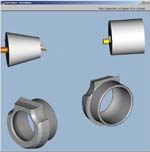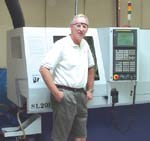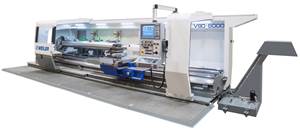Orthodontist Turns To CNC Swiss To Manufacture His Device
This orthodontist decided to take the plunge into CNC Swiss after having difficulty finding job shops with the machining time to make his parts, tiny components that go into an orthodontic appliance.
Dr. Stephen Hanks (Las Vegas, Nevada), an orthodontist who is also an adjunct professor at the UCLA School of Dentistry and an ordained Mormon minister, has added a few more titles to his résumé: manufacturing engineer, CNC Swiss programmer and setup person. These have been added in rapid succession since July of 2001, when Dr. Hanks decided to get into the Swiss machining business and culminated in January 2002 with his acquisition of a six-axis CNC Swiss-type lathe.
Dr. Hanks decided to take the plunge into CNC Swiss after having difficulty finding job shops with the machining time to make his parts, tiny components that go into an orthodontic device called a Herbst appliance. But before he made the investment, he wanted to be sure he could handle the complex CNC programming such a venture would entail. So he purchased PartMaker SwissCAM from IMCS Inc. (Fort Washington, Pennsylvania).
"I bought PartMaker SwissCAM to help me understand the concept of Swiss-turning," says Dr. Hanks. "That helped prepare for buying a machine."
Herbst appliances are designed to correct an overbite caused when the lower jaw is set too far back in the mouth. Often this condition is misdiagnosed as a regular overbite (where the upper jaw protrudes too far over the lower jaw).
Dr. Hanks himself suffered from this condition but refused to undergo the painful surgery necessary to correct it. Introduced to the concept of Herbst at an orthodontic conference in 1978, Dr. Hanks applied what he learned to cure his condition. He designed and built his own Herbst device, which he began using in 1992. He wore the appliance for 15 months and then began modifying and advancing the traditional Herbst design.
Dr. Hanks sought to produce and sell his device to other orthodontists. His goal was to exhibit at the American Association of Orthodontists Convention in May 2002. In the fall of 2000, he sent his designs to more than 30 CNC Swiss job shops. He was disappointed when only one company responded. Dr. Hanks concluded that he would be better off buying a CNC Swiss and machining his parts on his own if he wanted to complete them in time for the show.
"I figured it would cost a minimum of $50,000 to have my parts made, because I would have to commit to a certain level of product with no guarantee of selling any of it," Dr. Hanks says. "If I bought the machine and made the parts myself, I would not have to eat the inventory and would at least have the machine to resell if the venture did not work out."
Dr. Hanks settled on a Hanwha SL20HP Swiss-type lathe after feeling comfortable that he could use PartMaker SwissCAM to program it.
"Not having a CNC background and not being able to write G & M codes, PartMaker was the bridge from my part design to creating a part on the machine," says Dr. Hanks.
PartMaker is an off-line CAM programming software for multi-axis lathes with live tooling and CNC Swiss-type lathes. The software relies on a visual programming approach that operates from graphical representations of the various faces of the part. The software divides the part into planar or rotational faces that are graphically represented on the screen. The appropriate machining operations are then assigned to each face. The complete program becomes the sum of all of the machining operations on all of the faces.
PartMaker is a knowledge-based machining system. It includes an integrated tool database with data for the tools used on the machine tool being programmed. For repetitive operations such as center drilling, drilling, tapping, boring, chamfering and so on, the programmer needs only to create the cycle one time. The cycle can be stored in a cycles database, which is linked to the tools database. The software comes with a materials database with recommendations for average cutting parameters. Feed rate and spindle speed are computed based on tool geometry and machineability data.
When the programmer is satisfied with the views of the part and its job plan, he or she can proceed to post processing to automatically generate an NC program for a particular multi-axis lathe. Multiple programs with synchronization points are generated for Swiss-type lathes that require a separate program for each set of programmable axes. The software eliminates the need to manually edit the generated NC program.
PartMaker performs a full 3D simulation of the Swiss machining process on screen so the programmer can see any errors before machining the part. This allows the user to see part transfer and simultaneous operations being carried out on the main and sub spindles at the PC. Once the simulation is completed, the user can analyze a solid model of the machined part.
For Dr. Hanks, PartMaker allows him express his concepts in a method his CNC Swiss can understand.
"PartMaker writes the whole program," says Dr. Hanks. "This means I can conceptualize a part on Tuesday, program and set it up on Wednesday, machine it Thursday and have it by Friday to put into a patient's mouth for testing. That is unheard of in the industry."
Related Content
Palmgren Launches Combination Bench Lathe, Mill
The 11" bench engine lathe and gear head mill is able to handle a wide range of turning, milling and drilling operations typically found on much larger machinery.
Read MoreWeiler to Debut New Automation Features For Its Lathes
Weiler’s V 110 four-way precision lathe introduces features new to the U.S.
Read MoreInverting Turning and Five-Axis Milling at Famar
Automation is only the tip of the iceberg for Famar, which also provides multitasking options for its vertical lathes and horizontal five-axis machine tools.
Read MoreUnderstanding Swiss-Type Machining
Once seen as a specialty machine tool, the CNC Swiss-type is increasingly being used in shops that are full of more conventional CNC machines. For the newcomer to Swiss-type machining, here is what the learning curve is like.
Read MoreRead Next
The Cut Scene: The Finer Details of Large-Format Machining
Small details and features can have an outsized impact on large parts, such as Barbco’s collapsible utility drill head.
Read More3 Mistakes That Cause CNC Programs to Fail
Despite enhancements to manufacturing technology, there are still issues today that can cause programs to fail. These failures can cause lost time, scrapped parts, damaged machines and even injured operators.
Read More
















.png;maxWidth=300;quality=90)










